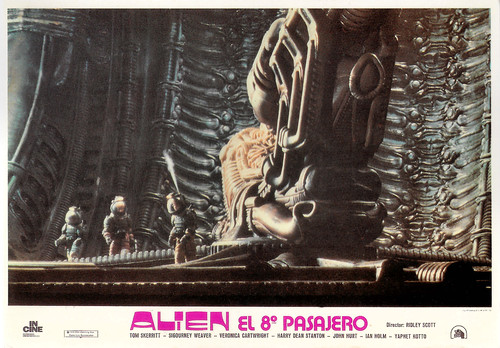
Spanish postcard by Editions Mercuri, no. 465. Photo: Sigourney Weaver in Alien (Ridley Scott, 1979). Caption: Alien el 8 pasajero.

French postcard by Editions Mercuri, no. 464. Image: Spanish lobby card for Alien (Ridley Scott, 1979). The Spanish title is 'Alien, el octavo pasajero'.
What should the monster look like
It is the year 2122. The U.S.C.S. Nostromo (Italian for "mate"), a commercial cargo spacecraft, is flying to Earth with several million tonnes of ore on board. The ship is manned by seven people and a sophisticated computer, which the crew call "Mother".
The crew members are the men Dallas, Ash, Kane, Parker and Brett and the women Ripley and Lambert. The crew is woken up from hibernation by the ship's Mother computer to answer a distress signal from a nearby planet. Capt. Dallas's (Tom Skerritt) rescue team discovers a bizarre pod field, but things get even stranger when a face-hugging creature bursts out of a pod and attaches itself to Kane (John Hurt).
Over the objections of Ripley (Sigourney Weaver), science officer Ash (Ian Holm) lets Kane back on the ship. The acid-blooded incubus detaches itself from an apparently recovered Kane, but an alien erupts from Kane's stomach and escapes. The alien starts stalking the humans, pitting Dallas and his crew (and cat) against a malevolent killing machine that also has a protector in the nefarious Company.
While still a student at the University of Southern California, scriptwriter Dan O'Bannon had teamed up with director John Carpenter to make a comic science fiction film called Dark Star (John Carpenter, 1974). His experience making this film gave Bannon the idea of making a similar film, but with a horror theme instead of a comedy.
A few years later, he began writing a screenplay around this idea. Around the same time, Ronald Shusett began working on a screenplay that would eventually become Total Recall (Paul Verhoeven, 1990). He contacted O'Bannon after seeing Dark Star, after which the two decided to work together on Alien. However, O'Bannon had not yet thought about what the monster should look like.

French postcard by Editions Mercuri, no. 466. Image: Spanish lobby card for Alien (Ridley Scott, 1979). The Spanish title is 'Alien, el octavo pasajero'.

French postcard by Editions Mercuri, no. 467. Image: Spanish lobby card for Alien (Ridley Scott, 1979). The Spanish title is 'Alien, el octavo pasajero'.
Ripley's forceful horror heroine
Swiss artist H.R. Giger's alien design and Carlo Rambaldi's visual effects for Alien (Ridley Scott, 1979) creepily meld technology with corporeality, creating a claustrophobic environment that is coldly mechanical yet horribly anthropomorphized, like the metallic monster itself. Director Ridley Scott keeps the alien out of full view, hiding it in the dark or camouflaging it in the workings of the Nostromo.
Lucia Bozzola at AllMovie: "Signs of '70s cultural upheaval permeate Alien's future world, from the relationship between corporate capitalism and rapacious monstrosity to the heterogeneous crew and Ripley's forceful horror heroine. However, the intense frights and gross-outs are credited with making Alien one of the biggest hits of 1979 (it premiered on the two-year anniversary of Star Wars); Giger, Rambaldi, et al. won the Oscar for Best Visual Effects."
Alien went on to spawn some genre-bending sequels: the actioner Aliens (James Cameron, 1986), the dark prison drama Alien 3 (David Fincher, 1992), and the exotically grotesque Alien Resurrection (Jean-Pierre Jeunet, 1997). In 2003, a director's cut of Alien (Ridley Scott, 1979) was released in cinemas, with some additional scenes. The franchise now counts seven films.
Roger Ebert: "Certainly the character of Ripley, played by Sigourney Weaver, would have appealed to readers in the Golden Age of Science Fiction. She has little interest in the romance of finding the alien, and still less in her employer's orders that it be brought back home as a potential weapon. After she sees what it can do, her response to "Special Order 24" ("Return alien lifeform, all other priorities rescinded") is succinct: "How do we kill it?" Her implacable hatred for the alien is the common thread running through all three "Alien" sequels, which have gradually descended in quality but retained their motivating obsession."

British postcard in the Mini Series by Lilliput Production, London, no. 505. Sigourney Weaver in Alien (Ridley Scott, 1979).

Belgian postcard by Raider Bounty / Joepie. Photo: publicity still for Alien (Ridley Scott, 1979).
Sources: Roger Ebert (RogerEbert.com), Lucia Bozzola (AllMovie), Wikipedia (Dutch), and IMDb.
No comments:
Post a Comment